Valee Shell Mp3 Download Valee 12 12 Again
In this article, we'll briefly explain the kernel scheduler (also known as the process scheduler), and procedure priority, which are topics across the scope of this guide. Then we will dive into a little fleck of Linux procedure management: see how to run a program or command with modified priority and also change the priority of running Linux processes.
Read Also: How to Monitor Linux Processes and Ready Process Limits on a Per-User Footing
Agreement the Linux Kernel Scheduler
A kernel scheduler is a unit of the kernel that determines the almost suitable process out of all runnable processes to execute next; information technology allocates processor time between the runnable processes on a system. A runnable process is one which is waiting simply for CPU time, it's prepare to be executed.
The scheduler forms the core of multitasking in Linux, using a priority-based scheduling algorithm to cull betwixt the runnable processes in the system. It ranks processes based on the near deserving besides as the need for CPU time.
Understanding Process Priority and Nice Value
The kernel stores a great deal of information about processes including process priority which is but the scheduling priority fastened to a process. Processes with a higher priority will be executed before those with a lower priority, while processes with the same priority are scheduled one afterwards the next, repeatedly.
In that location are a total of 140 priorities and two distinct priority ranges implemented in Linux. The first one is a dainty value (niceness) which ranges from -20 (highest priority value) to 19 (lowest priority value) and the default is 0, this is what we will uncover in this guide. The other is the real-time priority, which ranges from one to 99 by default, so 100 to 139 are meant for user-infinite.
One of import characteristic of Linux is dynamic priority-based scheduling, which allows the nice value of processes to exist changed (increased or decreased) depending on your needs, as we'll see afterward on.
How to Check Dainty Value of Linux Processes
To run into the prissy values of processes, nosotros can use utilities such as ps, tiptop or htop.
To view processes nice value with ps command in user-defined format (hither the NI the column shows the niceness of processes).
$ ps -eo pid,ppid,ni,comm
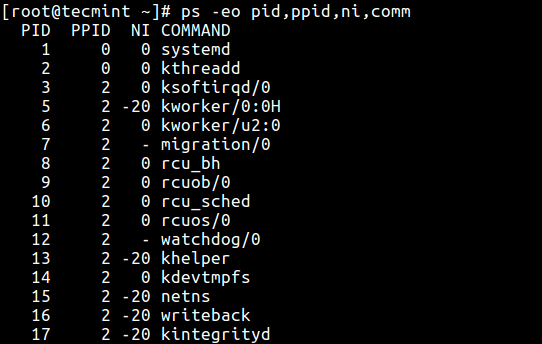
Alternatively, yous tin use top or htop utilities to view Linux processes nice values every bit shown.
$ meridian $ htop
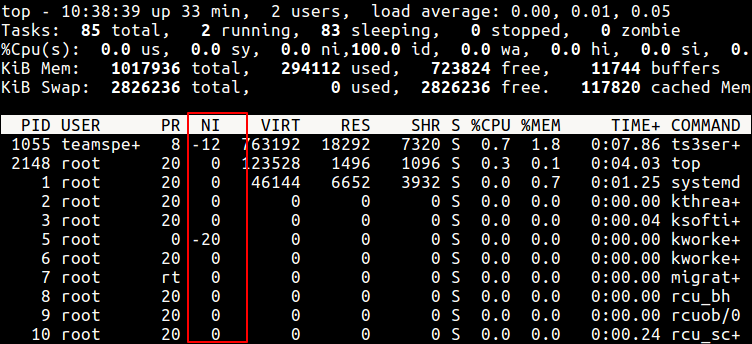
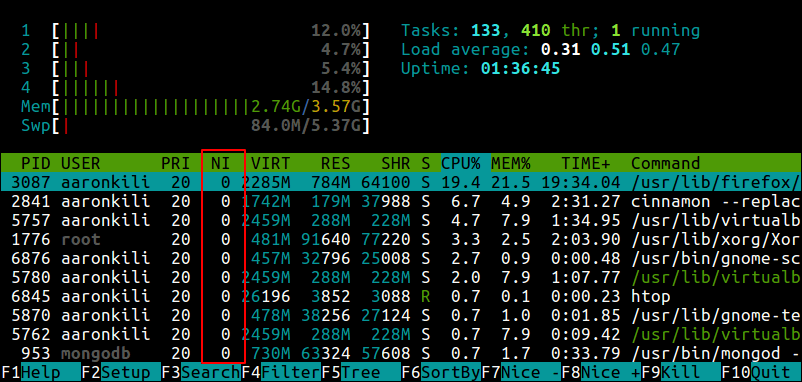
Departure Between PR or PRI and NI
From the superlative and htop outputs above, yous'll notice that at that place is a column called PR and PRI receptively which shows the priority of a procedure.
This, therefore, means that:
-
NI– is the nice value, which is a user-space concept, while -
PRorPRI– is the process'due south actual priority, every bit seen by the Linux kernel.
How To Calculate PR or PRI Values
Full number of priorities = 140 Real time priority range(PR or PRI): 0 to 99 User space priority range: 100 to 139
Prissy value range (NI): -twenty to nineteen
PR = 20 + NI PR = 20 + (-20 to + nineteen) PR = 20 + -twenty to 20 + nineteen PR = 0 to 39 which is same as 100 to 139.
But if you come across a rt rather than a number every bit shown in the screenshot below, information technology basically means the procedure is running nether real-time scheduling priority.
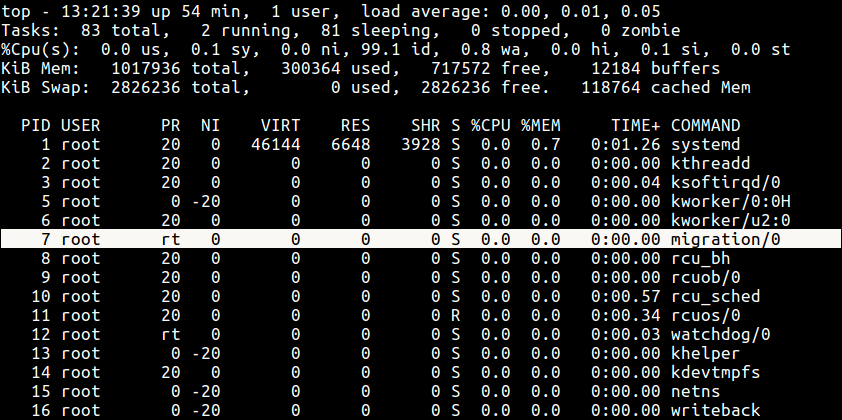
How to Run A Command with a Given Prissy Value in Linux
Here, we volition look at how to prioritize the CPU usage of a program or command. If you lot have a very CPU-intensive program or task, but you also empathise that it might take a long fourth dimension to consummate, you can set it a high or favorable priority using the nice control.
The syntax is as follows:
$ nice -n niceness-value [command args] OR $ nice -niceness-value [control args] #it's confusing for negative values OR $ overnice --aligning=niceness-value [command args]
Important:
- If no value is provided, nice sets a priority of 10 by default.
- A command or program run without squeamish defaults to a priority of cipher.
- Only root tin can run a command or program with increased or loftier priority.
- Normal users tin only run a command or programme with low priority.
For example, instead of starting a program or command with the default priority, you tin start it with a specific priority using post-obit prissy control.
$ sudo nice -n 5 tar -czf backup.tar.gz ./Documents/* OR $ sudo nice --aligning=v tar -czf backup.tar.gz ./Documents/*
You can also use the third method which is a lilliputian confusing especially for negative niceness values.
$ sudo nice -5 tar -czf backup.tar.gz ./Documents/*
Modify the Scheduling Priority of a Process in Linux
As nosotros mentioned before, Linux allows dynamic priority-based scheduling. Therefore, if a program is already running, you can change its priority with the renice command in this grade:
$ renice -northward -12 -p 1055 $ renice -north -ii -u apache

From the sample top output beneath, the niceness of the teamspe+ with PID 1055 is now -12 and for all processes owned by user apache is -2.
Still using this output, you can see the formula PR = xx + NI stands,
PR for ts3server = 20 + -12 = 8 PR for apache processes = twenty + -two = 18
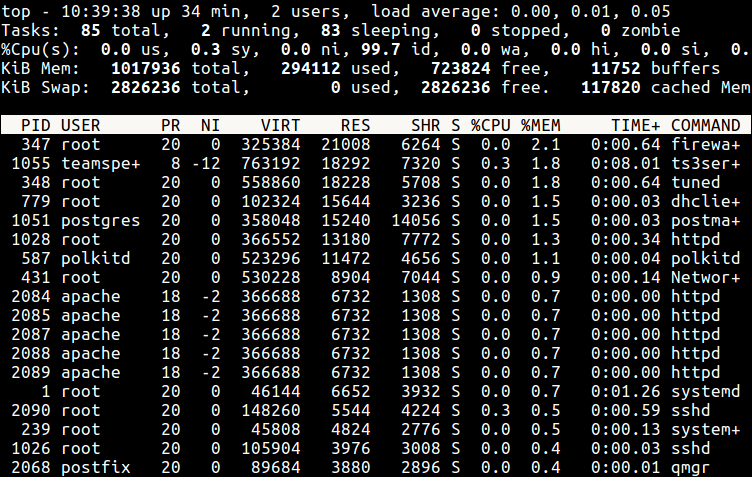
Any changes you make with renice command to a user's processes prissy values are only applicable until the next reboot. To ready permanent default values, read the adjacent section.
How To Ready Default Nice Value Of a Specific User's Processes
You can ready the default squeamish value of a particular user or group in the /etc/security/limits.conf file. Its primary role is to define the resource limits for the users logged in via PAM.
The syntax for defining a limit for a user is as follows (and the possible values of the various columns are explained in the file):
#<domain> <type> <item> <value>
Now use the syntax below where difficult – means enforcing hard links and soft means – enforcing the soft limits.
<username> <hard|soft> priority <prissy value>
Alternatively, create a file under /etc/security/limits.d/ which overrides settings in the main file above, and these files are read in alphabetical guild.
Beginning by creating the file /etc/security/limits.d/tecmint-priority.conf for user tecmint:
# vi /etc/security/limits.d/tecmint-priority.conf
Then add this configuration in information technology:
tecmint hard priority ten
Salvage and shut the file. From at present on, any process owned by tecmint will accept a nice value of 10 and PR of 30.
For more information, read the man pages of overnice and renice:
$ human being squeamish $ man renice
Y'all might also similar to read these following articles about Linux procedure management.
- How to Notice and Impale Running Processes in Linux
- A Guide to Impale, Pkill and Killall Commands to Terminate a Process in Linux
- How to Monitor Organisation Usage, Outages and Troubleshoot Linux Servers
- CPUTool – Limit and Control CPU Utilization of Whatsoever Process in Linux
In this article, we briefly explained the kernel scheduler, procedure priority, looked at how to run a programme or command with modified priority and also change the priority of active Linux processes. You can share whatsoever thoughts regarding this topic via the feedback course below.
If Y'all Capeesh What Nosotros Do Here On TecMint, You Should Consider:
TecMint is the fastest growing and most trusted community site for any kind of Linux Manufactures, Guides and Books on the web. Millions of people visit TecMint! to search or browse the thousands of published articles bachelor FREELY to all.
If yous like what you are reading, please consider ownership united states a java ( or 2 ) as a token of appreciation.

We are thankful for your never catastrophe support.
Source: https://www.tecmint.com/set-linux-process-priority-using-nice-and-renice-commands/
0 Response to "Valee Shell Mp3 Download Valee 12 12 Again"
Post a Comment